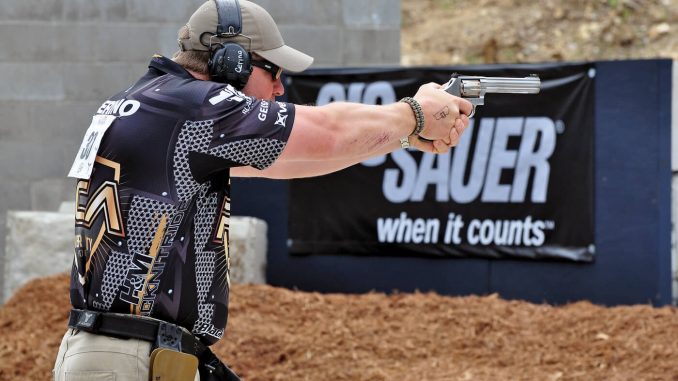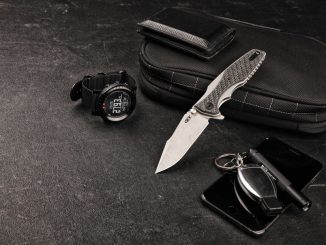
Talking about trigger management can be like bringing up politics or religion in conversation. Shooters get whipped into an ugly froth over the topic. Trigger finger placement and methods for running the trigger are catalysts for chaos. There is much to say on the topic.
Triggers are as different as their guns—revolvers, strikerfired, single-action, double-action, bolt-action and semiauto rifles. Trigger finger placement and trigger management are different for all of them. Changing what you do with each can make the difference in your success with them.
When referring to anything trigger related, “trigger management” is the preferred term, as opposed to “trigger reset.” Why focus on reset when it’s trigger press that most affects end results? Trigger management can be defined as “pressing the trigger without disturbing sight alignment or sight picture until the gun fires.” It doesn’t matter how slowly or how fast we do it.

The 1911 is the closest thing to a true button. The movement is straight and to the rear, exactly as a trigger press should be. Just do it without disturbing your sight picture. (Photo: Robb Manning)
TRIGGER RESET
Because of the actual click you hear and feel when you let the trigger out after firing, some are fascinated with trigger reset. They talk about “tactile” and “audible” reset as if they were key components of accuracy. The audible click of reset and the trigger’s movement after reset are different on every gun. But for some, it’s all about that click.
Surely, a good trigger makes even subpar firearms more shootable. Most “out-of-the-box” defensive pistols come with a two-stage trigger. “Two stage” means that there is pre-travel—or slack—before you meet the actual pressure wall. The second stage—or pressure wall—is where you begin to actually press the trigger to fire the gun. Some guns have very little first stage, and some have a lot. Single stage or two stage, we press from the pressure wall.
“Remember: you don’t shoot a group. A group happens by doing the same thing over and over again— the same sight alignment, sight picture and trigger press.”
STRIKER-FIRED GUNS AND GOD’S GIFT TO PISTOLCRAFT
Shooters who understand the value of having the same trigger press every time they fire know the value of modern-day striker-fired pistols. Before striker-fired pistols became prolific, the 1911 was the gun favored by many for its simple and clean trigger. With very little pre-travel, an adjustable trigger weight and little to no over-travel, the 1911 was—and still is—the choice of marksmen. Compared to the double-/single-action guns of the 1980s (think S&W Model 5906 or Beretta 92), it was much easier to obtain consistent accuracy with the 1911.
Then, Glock came to the market with a light weight, no manual safeties, high capacity and a trigger pull that was the same every single time. Finally—there was a defensive pistol that required less training in the way of trigger manipulation and was almost as simple as the original “point and click” technology: revolvers.
The Glock has the same trigger press every time, but, from first shot to consecutive shots, trainers often teach to manage the trigger as if each trigger pull were different.
Press the trigger, the gun fires, pin the trigger to the rear, let the gun settle back to the target, slowly let the trigger out until you hear the click, and you’re ready to fire again. Why waste the time?
If you have a revolver and slowly let its trigger out until you hear the click and then try to press it again, it locks up! Many instructors are teaching trigger management based on just one gun, and shooters are applying that trigger management to all guns. It’s not good.
I don’t understand why anyone is teaching shooters to feel for the click. Maybe it was because your daddy said, “Never let your trigger finger leave the face of the trigger.” Or maybe it is a way of showing students how to find the second stage (pressure wall). This is certainly a painfully slow way to show shooters how far they need to come off the trigger before the gun can fire again. One thing I am sure of: The process soon turns into click—bang! and accuracy suffers.
“Don’t waste time doing things that don’t increase accuracy. Spend time pressing the trigger.”
KEEPING IT SIMPLE
On presentation of the pistol, the trigger finger meets the trigger face, comes through the slack/pre-travel and feels the pressure wall before beginning the trigger press. No matter how fast or slowly you press the trigger, it must be done from the pressure wall to obtain a press and not a trigger jerk.
The opposite side of the reset is the pressure wall. So, for subsequent shots, don’t waste time letting the trigger out to the reset. Reset during recoil and be at the pressure wall when the gun settles—your time is better spent pressing the trigger. Guns have different triggers, different reset points and different amounts of pre-travel after reset. I understand keeping your trigger finger close to the trigger face, but why the need to feel the click?
Defensive or competitive use of guns in action sports doesn’t offer generous amounts of time. Heck, there is barely enough time to press off a good shot from the pressure wall.

Timed fire drills are a sure way to bring out trigger management issues. The targets tell the story.
What I find when training people who’ve learned to feel for the click when firing multiple shots is that the first shot is their best, because they are firing from the pressure wall and they are putting sights, sight picture and trigger management together all at once. The next shot or shots are trigger jerks, generally low and left for right-handers. They wait for the gun to settle, align the sights, feel the click—and bang!—slap the trigger because they feel rushed to shoot fast.
The solution is to learn to manage the trigger the same way for each shot. Good trigger management makes for good groups. Remember: You don’t shoot a group. A group happens by doing the same thing over and over again—the same sight alignment, sight picture and trigger press.
Move fast where you can. Slow down where you need to. Move to the pressure wall upon presentation of the pistol; and, as the sights settle and the sight picture happens, be applying pressure to the trigger until the gun fires. When the gun recoils, quickly reset. As sight alignment and sight picture come back together, be back on the pressure wall, applying pressure to be ready to fire accurately again.

A striker-fired gun might be easier to fire than a revolver, but it’s still a lever. It takes pressure—just not as much. (Photo: Robb Manning)
Don’t waste time doing things that don’t increase accuracy. Spend time pressing the trigger.
The speed with which I complete the firing process has everything to do with the size of, and the distance to, the target.
Take these techniques to the range next time. I’m sure you’ll find that this economy of motion improves both your speed and accuracy.
More about trigger management in future columns.
About the Author
Chris Cerino is a 25-year law enforcement and training professional. He competes in shooting sports to validate his skills. Chris writes on the topic of training and can be seen on a variety of TV shows.
Editor’s note: A version of this article first appeared in the November 2018 print issue of Gun World Magazine.







Be the first to comment